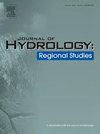A fusion strategy for terrestrial water storage anomaly inversion using joint GNSS and GRACE for Southwest China
IF 4.7
2区 地球科学
Q1 WATER RESOURCES
引用次数: 0
Abstract
Study region
The southwest China covers Yunnan, Guizhou, Sichuan, Guangxi, and Chongqing. The region is influenced by monsoon climate and complex topography, with complex hydrological processes and significant spatial and temporal heterogeneity.
Study focus
The Gravity Recovery and Climate Experiment (GRACE) satellite data demonstrate high accuracy; however, their spatial and temporal resolution is low, and there is a window of almost one year. Conversely, the Global Navigation Satellite System (GNSS) satellite data have high spatial and temporal resolution, but their accuracy is low. In this study, a novel Adaptive Weighted Fusion TWSA Inversion Method (AWFTM) is proposed to achieve the complementary advantages of GNSS and GRACE, in order to invert the TWSA results with high accuracy and high spatial and temporal resolution.
New hydrological insights for the region
The temporal and spatial evolution characteristics of TWSA in southwest China from 2011 to 2022 were analyzed using AWFTM inversion. The study found that TWSA increased dramatically during 2014–2016, a phenomenon closely related to the strong convective weather and extreme heavy rainfall triggered by the super El Niño event during the same period, which led to significant changes in regional water storage. Further analysis shows that the TWSA and rainfall data from the AWFTM inversion are highly consistent across the provinces in southwest China, with their peaks located in southwest Yunnan Province and southeast Guangxi Province. The results not only validate the spatial reliability of AWFTM, but also provide a powerful dataset that can support disaster prevention, water resource management, and ecological protection in the region.
基于GNSS和GRACE联合反演西南地区陆地蓄水异常的融合策略
研究区域中国西南地区包括云南、贵州、四川、广西和重庆。该地区受季风气候和复杂地形的影响,水文过程复杂,时空异质性显著。GRACE (Gravity Recovery and Climate Experiment)卫星数据精度高;然而,它们的时空分辨率较低,存在近一年的窗口期。相反,全球导航卫星系统(GNSS)卫星数据具有较高的时空分辨率,但精度较低。本研究利用GNSS和GRACE的优势互补,提出了一种新的自适应加权融合TWSA反演方法(AWFTM),以高精度、高时空分辨率反演TWSA结果。利用AWFTM反演分析了2011 - 2022年中国西南地区TWSA的时空演变特征。研究发现,2014-2016年TWSA急剧增加,这一现象与同期超级厄尔Niño事件引发的强对流天气和极端强降雨密切相关,导致区域储水量发生显著变化。进一步分析表明,TWSA与AWFTM反演降水数据在西南各省间具有高度一致性,峰值位于云南西南部和广西东南部。研究结果不仅验证了AWFTM的空间可靠性,而且为该地区的防灾、水资源管理和生态保护提供了强大的数据支持。
本文章由计算机程序翻译,如有差异,请以英文原文为准。
求助全文
约1分钟内获得全文
求助全文
来源期刊

Journal of Hydrology-Regional Studies
Earth and Planetary Sciences-Earth and Planetary Sciences (miscellaneous)
CiteScore
6.70
自引率
8.50%
发文量
284
审稿时长
60 days
期刊介绍:
Journal of Hydrology: Regional Studies publishes original research papers enhancing the science of hydrology and aiming at region-specific problems, past and future conditions, analysis, review and solutions. The journal particularly welcomes research papers that deliver new insights into region-specific hydrological processes and responses to changing conditions, as well as contributions that incorporate interdisciplinarity and translational science.
 求助内容:
求助内容: 应助结果提醒方式:
应助结果提醒方式:


